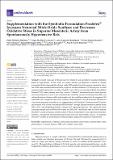Por favor, use este identificador para citar o enlazar a este item:
http://hdl.handle.net/10261/285198COMPARTIR / EXPORTAR:
 SHARE SHARE
 CORE
BASE CORE
BASE
|
|
| Visualizar otros formatos: MARC | Dublin Core | RDF | ORE | MODS | METS | DIDL | DATACITE | |

| Título: | Supplementation with the symbiotic formulation Prodefen® increases neuronal nitric oxide synthase and decreases oxidative stress in superior mesenteric artery from spontaneously hypertensive rats |
Autor: | Méndez-Albiñana, Pablo CSIC; Martínez-González, Miguel Ángel; Camacho-Rodríguez, Laura; Ferreira-Lazarte, Alvaro CSIC ORCID ; Villamiel, Mar CSIC ORCID ; Rodrigues-Díez, Raquel; Balfagón, Gloria; García-Redondo, Ana B.; Prieto-Nieto, Mª Isabel; Blanco-Rivero, Javier | Palabras clave: | Hypertension Nrf2 Synbiotic Oxidative stress Perivascular mesenteric innervation PI3K-AKT Neuronal nitric oxide Protein kinase C Protein kinase A |
Fecha de publicación: | 2022 | Editor: | Multidisciplinary Digital Publishing Institute | Citación: | Antioxidants 11(4): 680 (2022) | Resumen: | In recent years, gut dysbiosis has been related to some peripheral vascular alterations linked to hypertension. In this work, we explore whether gut dysbiosis is related to vascular innervation dysfunction and altered nitric oxide (NO) production in the superior mesenteric artery, one of the main vascular beds involved in peripheral vascular resistance. For this purpose, we used spontaneously hypertensive rats, either treated or not with the commercial synbiotic formulation Prodefen® (108 colony forming units/day, 4 weeks). Prodefen® diminished systolic blood pressure and serum endotoxin, as well as the vasoconstriction elicited by electrical field stimulation (EFS), and enhanced acetic and butyric acid in fecal samples, and the vasodilation induced by the exogenous NO donor DEA-NO. Unspecific nitric oxide synthase (NOS) inhibitor L-NAME increased EFS-induced vasoconstriction more markedly in rats supplemented with Prodefen®. Both neuronal NO release and neuronal NOS activity were enhanced by Prodefen®, through a hyperactivation of protein kinase (PK)A, PKC and phosphatidylinositol 3 kinase-AKT signaling pathways. The superoxide anion scavenger tempol increased both NO release and DEA-NO vasodilation only in control animals. Prodefen® caused an increase in both nuclear erythroid related factor 2 and superoxide dismutase activities, consequently reducing both superoxide anion and peroxynitrite releases. In summary, Prodefen® could be an interesting non-pharmacological approach to ameliorate hypertension. | Descripción: | This article belongs to the Special Issue Antioxidant Foods and Cardiometabolic Health. | Versión del editor: | https://doi.org/10.3390/antiox11040680 | URI: | http://hdl.handle.net/10261/285198 | DOI: | 10.3390/antiox11040680 | E-ISSN: | 2076-3921 |
| Aparece en las colecciones: | (CIAL) Artículos |
Ficheros en este ítem:
| Fichero | Descripción | Tamaño | Formato | |
|---|---|---|---|---|
| supplerat.pdf | 1,91 MB | Adobe PDF |  Visualizar/Abrir |
CORE Recommender
PubMed Central
Citations
4
checked on 01-may-2024
SCOPUSTM
Citations
5
checked on 14-may-2024
WEB OF SCIENCETM
Citations
4
checked on 27-feb-2024
Page view(s)
35
checked on 19-may-2024
Download(s)
47
checked on 19-may-2024

